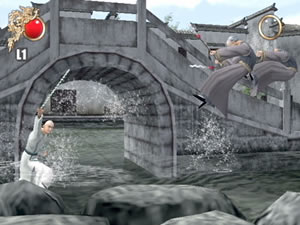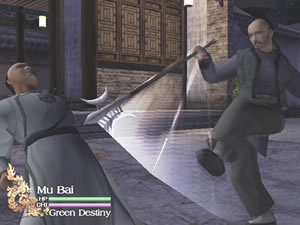Bad Tiger! Bad Dragon! No sequel for you!
In the world of kung-fu, your skill and the art in which you display your martial style is a direct reflection of your worth as an honorable warrior. To show poor skill when facing a greater fighter is to give him no “face” – although simply kicking a lot of ass tends to speak volumes no matter how you slice it.
Unfortunately, Ubisoft’s third-person action hack n’ slash Crouching
Tiger, Hidden Dragon does none of the above.
CTHD
is the video game adaptation of Ang Lee’s hit movie of the same name. The movie
was adapted from part of the fourth book in a five-book
series collectively titled The Crane – Iron Pentology written by
acclaimed wuxia
novelist Wang Du Lu. With that long-winded history, you’d think Ubisoft would
have taken great steps to properly honor the since deceased novelist. But right
from the beginning, this shameless offering does nothing of the sort.
Seasoned kung-fu practitioners can usually spot great form by observing an
opponent’s strong stance. However, CTHD‘s stance is weak and
watery, opting to rehash the exact same plot seen in the movie. This is often
the hallmark of simplicity and lack of creativity. To the game’s credit, you
will at least get to see video clips of the movie’s best scenes, but don’t expect
anything new from the story.
As the plot progresses you will play as each of the movie’s four main characters
– the legendary wuxia Li Mu Bai, his friend Shu Lien, the young upstart Jen
and her forbidden lover, the nomadic Dark Cloud. In between cinemas, the game
plops you down in an area where you will fight several swarms of relatively
mindless lackeys armed with swords, staves, throwing darts, sabers and so on.
Fallen foes will drop health potions and weapons to keep you going. After you
repeatedly beat the tar out everyone in a given area, you must follow the blue
torches and proceed to the next.
The fighting is one part innovation to 99 parts repetition. All you do on
every single level is button-mash with your prosaic list of combos and strikes.
You’ll be bored before your character can work up a virtual sweat.
Controlling your avatar is simple enough. You have four attacks: unarmed light,
unarmed heavy, armed light and armed heavy. Tap different attack types and you
can perform a combo (ex: unarmed light, light, heavy). As you can imagine there
are not many variations and you will have seen nearly every attack in about
an hour.
 One
One
combat feature is worthy of a brow-raise. Combo blocks allow you to combo your
defensive moves and parries by consecutively pressing the block button at the
appropriate times. When it works (which isn’t often), it can look pretty cool.
But even here you will have seen all the block combos before long and your enemies
aren’t putting up enough of a fight to warrant learning the frolicsome skill.
Also, the camera is less than friendly. It can be controlled with the right analog stick but it is a lunky, tiresome affair that further impedes any intended fun-factor.
The movie and even the comic book show high production values. Sadly, the
game’s engine does not. Easily on par with a first-generation PS2 game, CTHD
looks bland and featureless. Textures shows little detail and colors are few
and simple. The characters models are comprised of minimal polygons, leaving
them bulky and lifeless. The animations are the one highlight, but even they
earn the game no bragging rights.
There are a couple things that are done well, though these have nothing to
do with gameplay. One is the music, which is taken note-for-note right out of
the movie. But that begs the question, “Why not just watch the movie?” The other
is the impressive comic book images from ComicsOne‘s
Crouching Tiger, Hidden Dragon graphic novel by Hong Kong comic creator
Andy Seto. These can be unlocked as you play through the game. Yet again this
begs the question,”Why not buy the comic?” Both the DVD and the graphic novel
are a fraction of what it costs to buy the game.
And make no mistake – the Crouching Tiger, Hidden Dragon
game is just not any fun at all. It’s grossly repetitive, strictly linear and
painfully boring. For a young audience of primates with low expectation and
few brain cells, this might pass as a one-time rental. All other fans of anything
kung-fu, don’t lose face; show the late Wang Du Lu some respect and avoid this
one like a kung-fu fighting leper.

-
Movie scenes and music
-
Boring Tiger, Bland Dragon
-
Weak combat system
-
Horrible graphics
-
Too linear
-
Dishonorable!










